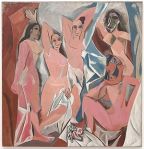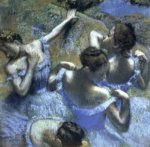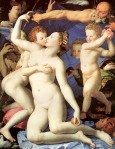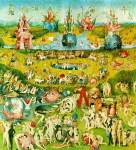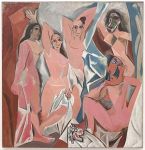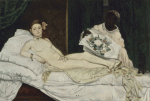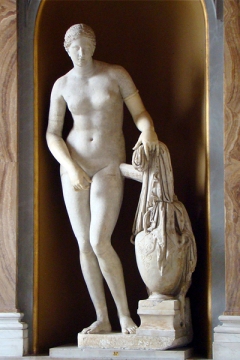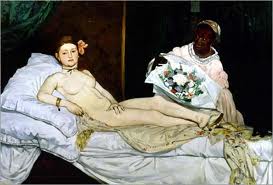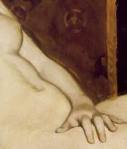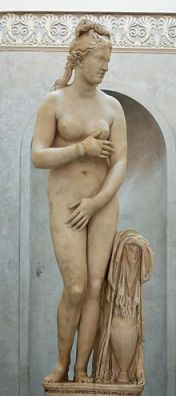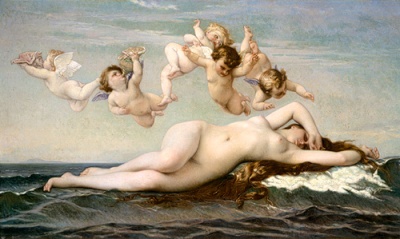“Art is the most effective mode of communications that exists.”
 Future teachers will find the process of building a personal teaching philosophy an important exercise in developing into a successful teacher. A teaching philosophy is the culmination of ideas about who one is as ‘teacher’, how the student is perceived as ‘learner’ and how one’s particular subject matter brings teacher and learner together in a dynamic full of complex learning issues. It is about creating an appropriate teaching approach to the lessons, as they present both abstract and concrete concepts, and to the students who need a positive and emotionally safe environment to learn in.
Future teachers will find the process of building a personal teaching philosophy an important exercise in developing into a successful teacher. A teaching philosophy is the culmination of ideas about who one is as ‘teacher’, how the student is perceived as ‘learner’ and how one’s particular subject matter brings teacher and learner together in a dynamic full of complex learning issues. It is about creating an appropriate teaching approach to the lessons, as they present both abstract and concrete concepts, and to the students who need a positive and emotionally safe environment to learn in.
I believe art is a very special subject to teach. The question of ‘what is art?’ has no correct answer. To begin to teach a subject with gray areas and fuzzy edges poses a challenge from the start. All other core subjects have more defined margins and are more clearly assessable. Many of the values of learning the visual arts are esoteric and almost spiritual in nature, with each individual drawing from the arts what is personal. I have asked myself how to distill and contain a broad and margin-less subject and still manage to teach it with depth and wisdom.
 To answer this question, I begin with defining my core purpose for teaching the arts in school. The core purpose for teaching the visual arts is to teach each student how to see, and through this refined sensibility, deeper thinking follows. The study of the arts reaches far beyond the skills required to master the mediums of painting, drawing, ceramics, printmaking and photography. The process of learning the skills to see and think is the purpose of teaching art in school. An artist who stands in mastery at her easel has accomplished far more than color theory and perspective. She has learned to see and to think deeply.
To answer this question, I begin with defining my core purpose for teaching the arts in school. The core purpose for teaching the visual arts is to teach each student how to see, and through this refined sensibility, deeper thinking follows. The study of the arts reaches far beyond the skills required to master the mediums of painting, drawing, ceramics, printmaking and photography. The process of learning the skills to see and think is the purpose of teaching art in school. An artist who stands in mastery at her easel has accomplished far more than color theory and perspective. She has learned to see and to think deeply.
I want students not just to identify or recognize things in the world, but also to really see them. They practice seeing by looking closely at a single leaf and noticing the many shades of green on its surface, or seeing all the visible colors in clear glass, or finding the symbols and allegory in old masters’ paintings. It is an attunement to the subtle. Once a student is attuned to the subtle, they process and consider more about the world. This skill not only makes great artists, but great human beings as well. Teaching students to see and think deeply cannot be taught concretely like math, but must be modeled or allowed to unfold through experience and maturity.
 To perceive more makes people more mindful about issues and creates deeper and broader thinkers, opening humans to growth and personal transformation This idea is also supported by Elliot Eisner who is emeritus professor of Art and Education at the Stanford University School of Education. He is a contemporary author who wrote the book, The Arts and the Creation of the Mind. Eisner wrote, “Working in art is a way of creating our lives by expanding our consciousness, shaping our dispositions, satisfying our quest for meaning, establishing contact with others, and sharing a culture.” Then he added, “work in the arts also invites the development of a disposition to tolerate ambiguity, to explore what is uncertain, to exercise judgment free from prescriptive rules and procedures.” [i] Eisner’s comments reflect my belief that art education should be experienced by all students, regardless of their future interests, because it teaches them lessons that will influence and make an impact on their future perspectives.
To perceive more makes people more mindful about issues and creates deeper and broader thinkers, opening humans to growth and personal transformation This idea is also supported by Elliot Eisner who is emeritus professor of Art and Education at the Stanford University School of Education. He is a contemporary author who wrote the book, The Arts and the Creation of the Mind. Eisner wrote, “Working in art is a way of creating our lives by expanding our consciousness, shaping our dispositions, satisfying our quest for meaning, establishing contact with others, and sharing a culture.” Then he added, “work in the arts also invites the development of a disposition to tolerate ambiguity, to explore what is uncertain, to exercise judgment free from prescriptive rules and procedures.” [i] Eisner’s comments reflect my belief that art education should be experienced by all students, regardless of their future interests, because it teaches them lessons that will influence and make an impact on their future perspectives.
My core purpose for art education defines the centrality of my teaching while other important, supportive lessons wrap around it in layers. The next layer of important lessons an art education concerns the practice of concrete skills, the correct use of materials, learning the descriptive language of art, and a solid base of art history and art criticism. Here is where my teaching philosophy fragments and, while maintaining a state of organic development as the students learn to see, I become a master of production as students practice skills like drawing and painting, and learn to speak about art while they learn to analyze and criticize. These lessons make up the tangible elements of a good art education. My philosophy resembles ‘Experimentalism’ in that my primary concern is to teach students to think effectively. [ii] As students learn to see, they will combine their knowledge of the sublime with their honed technical skills and begin to create meaningful works of art.
 The next layer of art lessons that I envision wrapped around the lessons of skill connects art back to our inner selves and to the relationships of the things around us. Art becomes about personal experience. The next layer of lessons promotes creativity, imagination and problem solving, self-expression and play. It is a time of experimentation with emotions, materials, colors and mediums. Experimentation yields experience. Through this experimentation, students learn representation, or to intelligently and accurately translate an ephemeral idea into a concrete form that can be shared and discussed. Once again, Elliot Eisner in his book, The Art and the Creation of the Mind, comments on the importance of experience in education, “Experience is central to growth because experience is the medium of education. Education in turn is the process of learning to create ourselves, and it is what the arts, both as a process and as the fruits of that process promote.”[iii]
The next layer of art lessons that I envision wrapped around the lessons of skill connects art back to our inner selves and to the relationships of the things around us. Art becomes about personal experience. The next layer of lessons promotes creativity, imagination and problem solving, self-expression and play. It is a time of experimentation with emotions, materials, colors and mediums. Experimentation yields experience. Through this experimentation, students learn representation, or to intelligently and accurately translate an ephemeral idea into a concrete form that can be shared and discussed. Once again, Elliot Eisner in his book, The Art and the Creation of the Mind, comments on the importance of experience in education, “Experience is central to growth because experience is the medium of education. Education in turn is the process of learning to create ourselves, and it is what the arts, both as a process and as the fruits of that process promote.”[iii]
At this point, students are called to use all the layers of their art education experience. They must now use their developing artistic skills, their knowledge of color, form and composition and their aesthetic experiences, and move on to infuse all of this with personal expression and their ability to see to create complete works of art. John Dewey believed that the complete process of making art moved art beyond being a material object and became about a life changing experience. Dewey commented on the intellectual demands of an artist in the following statement:
 Any idea that ignores the necessary role of intelligence in the production of works of art is based upon the identification of thinking with the use of one special kind of material, verbal signs and words. To think effectively in terms of relations of qualities is as severe a demand upon thought as to think in terms of symbols, verbal and mathematical. Indeed, since words are easily manipulated in mechanical ways, the production of a work of genuine art probably demands more intelligence than does most of the so-called thinking that goes on among those who pride themselves on being ‘intellectuals’. [iv]
Any idea that ignores the necessary role of intelligence in the production of works of art is based upon the identification of thinking with the use of one special kind of material, verbal signs and words. To think effectively in terms of relations of qualities is as severe a demand upon thought as to think in terms of symbols, verbal and mathematical. Indeed, since words are easily manipulated in mechanical ways, the production of a work of genuine art probably demands more intelligence than does most of the so-called thinking that goes on among those who pride themselves on being ‘intellectuals’. [iv]
In order to orchestrate such vast developing qualities in my art students, I believe another approach to teaching must be utilized; teacher as guide and companion. As stated by Herbert Kliebard, in his metaphor of curriculum as ‘travel’, the teacher’s job is to now plot the route, and gently guide the students without rigid expectations down the path toward mastery.[v]
The final layer of lessons I see wrapped around the central goal to teach students to be deep thinkers and seers, is to move art from a deeply personal place to the public arena where it becomes part of the culture. Students will begin to learn how to represent their ideas and through their representations, to communicate. As Elliot Eisner explains, a culture grows through the exchange of ideas and people’s responses to art fuel new thoughts as the creative cycles continue. Therefore, artwork contributes to culture in that it furthers education and enriches other’s lives.[vi]
 The final process of moving students’ artwork into the public is again accomplished as teacher being guide and companion. I, as guide, need to forge the path and walk the blossoming art students into the realm of public art. This is often a fragile and vulnerable time for students as they learn to trust the message of their work, take criticism and speak publicly about their ideas. This is a time for unconditional support and celebration of their work.
The final process of moving students’ artwork into the public is again accomplished as teacher being guide and companion. I, as guide, need to forge the path and walk the blossoming art students into the realm of public art. This is often a fragile and vulnerable time for students as they learn to trust the message of their work, take criticism and speak publicly about their ideas. This is a time for unconditional support and celebration of their work.
The ‘art’ of teaching art is about empowering each student. Art is not simply the regurgitation of a package of prescribed ideas, but about original, new ideas flowing from the internal spaces of each student. This makes the production of art a vulnerable exercise. Any human who is required to share anything about him or her self can only be expected to do this while feeling safe in a positive and supportive environment. Therefore, the art classroom must be set up to facilitate confidence, freedom, experimentation, safety and acceptance.
These qualities are fostered by establishing respect in the classroom. With respect follows trust, honesty and safety. Respect must be required not just between teacher and student, but between each student as well. As a teacher I can foster these qualities with a gentle approach, by listening, supporting and guiding with constructive critique. The environment must be interesting, open and fun and not reduced to punitive measures to prod students to move forward. All of art’s great lessons will be lost is if the learning environment does not allow the lessons to seep down and resonate on an emotional level. Actually, I believe this about all learning; that learning is successful only if synchronized with the body, spirit and emotions of the learner.
 An example of how I saw this in practice was at an after school program I tutored at for a teaching practicum. Each element of the program, when isolated, seemed to work well. There was a snack, an active exercise, math, reading, homework time and a large group exercise. The program fell short upon combining all the elements together in the classroom. The missing ingredient to what seemed like a perfect program was the lack of integration of the activities with the children’s spirit or essential energy. In other words, the activities were burdened with punitive controls and the flow from one activity to another was not easy and organic, but stressful, so the best activities had little effect.
An example of how I saw this in practice was at an after school program I tutored at for a teaching practicum. Each element of the program, when isolated, seemed to work well. There was a snack, an active exercise, math, reading, homework time and a large group exercise. The program fell short upon combining all the elements together in the classroom. The missing ingredient to what seemed like a perfect program was the lack of integration of the activities with the children’s spirit or essential energy. In other words, the activities were burdened with punitive controls and the flow from one activity to another was not easy and organic, but stressful, so the best activities had little effect.
Good teaching is not just about the subject matter and good classroom management, but about loving people and drawing from a deeper level of emotions and sensitivity while teaching ‘up top’. Students are often governed by more subtle influences like hunger, peer pressure, self-doubt, and boredom and family stresses. Their behaviors and their level of academic engagement are often a meter of how strong these other powers are in their life. While ultimately they have to be held responsible for their academic requirements, guiding them to mastery will come by working with these outside pressures and not simply punishing their effects on the student’s performance.
In summary, my teaching philosophy begins with holding true to what I believe to be the central value of an arts education: to teach the students to truly see and think deeply about our world. A solid arts education is made of many different facets from the technical skills of drawing and painting, to the important connection of our inner lives to our art, to developing good representations of our ideas to moving these ideas into the public and contributing to the growth of our culture. Each of these educational elements requires a different teaching approach. The mastery of some lessons can result from hard work and practice, while some lessons are learned over time as students unfold in maturity and gain experience. Art, as stated earlier, is a subject with no clear margins, so its mastery is dependent on drawing holistically from a person’s being. No one teaching method can successfully be used to help a student develop all the diverse qualities needed to become an ‘artist complete’. Coupled with the complex task of teaching art, comes the challenge of providing the nurturing environment to in which to complete this task. The best art lessons, again, are lost if the students are not receptive. The best environments are constructed from respect, safety, a sense of fun and gentleness in handling the soul of the learner.
Note: All the of featured artwork is done by the students at Edgewood Campus School under the direction of their art teacher, Ruth Vander-Horck
[i] Elliot W. Eisner, The Arts and the Creation of the Mind (New Haven: Yale University Press, 2002), 3.
[ii] Carl A. Grant and Maureen Gillette, “Chapter Nine: Pursuing an Education” in Teaching in the 21st Century: Introduction to Education
[iii] Elliot W. Eisner, The Arts and the Creation of the Mind (New Haven: Yale University Press, 2002), 3.
[iv] John Dewey, The Art of Experience (New York, Perigee Books, 1934), 46.
[v] Herbert Kliebard, “Metaphorical Roots of Curriculum Design,” The Teachers Record Volume, Volume 73, Number 3, 1972, http://www.tcrecord.org/id/1583 (accessed August19, 2011).
[vi] Elliot W. Eisner, The Arts and the Creation of the Mind (New Haven: Yale University Press, 2002), 7.
Bibliography
Dewey, John. The Art of Experience. New York: Perigee Books, 1934.
Eisner, Elliot W. The Arts and the Creation of the Mind. New Haven: Yale University Press, 2002.
Grant, Grant A. and Maureen Gillette, “Chapter Nine: Pursuing an Education” in Teaching in the 21st Century: Introduction to Education
Kliebard, Herbert. “Metaphorical Roots of Curriculum Design,” The Teachers Record Volume, Volume 73, Number 3, 1972. http://www.tcrecord.org/id/1583 (accessed August19,2011).












